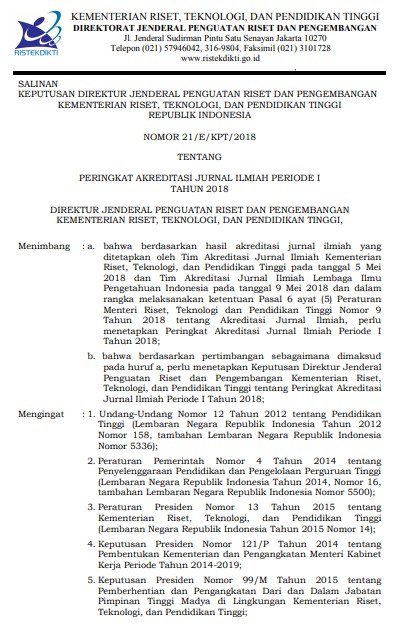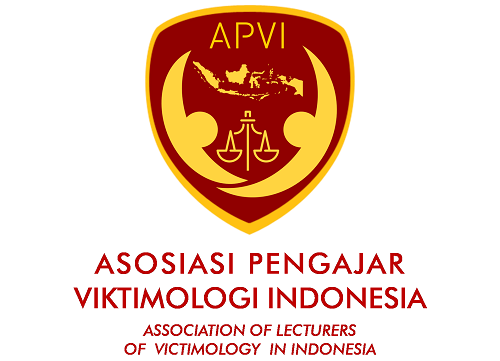Promoting Traditional Cultural Expressions via YouTube
Abstract
YouTube is a potential media to promote Indonesian traditional cultural expressions in Indonesia. Even though the promotion of traditional cultural expressions is growing fast, the communal intellectual property law is still a big question mark. The purposes of this paper are, first, to identify how YouTube impact on utilizing Indonesian culture, to analyze how to gain economic benefit from broadcasting through YouTube, and to note how to balance rights and obligations between traditional cultural expressions stakeholders. From a methodological standpoint, this paper used both a normative and ethnography-legal research approach. This paper result is, first, YouTube gives influence directly and indirectly to the promotion of traditional cultural expressions; and second, custodian and performers of traditional cultural expressions potentially receive the economic benefit from broadcasting through YouTube. Ultimately, petahelix approach is required in obtaining a balance right and obligation between traditional cultural stakeholders.
Keywords: YouTube, Traditional Cultural Expressions, Intellectual Property, Copyright
Full Text:
PDF View
References
Ambast, S. (2008). Protecting performers’ rights: Does India need law reform? Journal of Intellectual Property Rights, 13(6), 574–582.
Aragon, L. V. (2012). Copyrighting Culture for the Nation? Intangible Property Nationalism and the Regional Arts of Indonesia. International Journal of Cultural Property, 19(Special Issue 03), 269–312. https://doi.org/doi:10.1017/S0940739112000203
Ariyarathna, L. (2019). Streaming of Digital Content and Right of Reproduction in Australia: A Dubious Matter for End-Users. European Intellectual Property Review, 41(2), 89.
Australia Council for the Arts. (2007). Protocols for producing Indigenous Australian music (No. 2nd edition). Surry Hills.
B. Arewa, O. (2010). YouTube, UGC , and Digital Music: Competing Business and Introduction : The Rise of UGC. Northwesten University Law Review, 431, 1–36.
Boroughf, B. (2015). THE NEXT GREAT YOUTUBE : IMPROVING CONTENT ID TO FOSTER CREATIVITY , COOPERATION , AND FAIR COMPENSATION. Albany Law Journal of Science and Technology, 25(1), 95–127.
Buana, M. S. (2016). Living adat Law , Indigenous Peoples and the State Law : A Complex Map of Legal Pluralism in Indonesia. International Journal of Indonesian Studies, 104–213.
Burri, M. (2010). Digital Technologies and Traditional Cultural Expressions: A Positive Look at a Difficult Relationship. International Journal of Cultural Property, 17(1), 33–63. https://doi.org/10.1017/S0940739110000032
Dachlan, R. (2015). Indonesia’s Implementation of Inventory Obligation under UNESCO’s Intangible Cultural Heritage Convention: Problems in the Online Inventories. International Journal of Cultural Property, 22(01), 131–151. https://doi.org/10.1017/S0940739115000041
Dehghani, M., Khorram, M., Ramezani, I., & Sali, R. (2016). Computers in Human Behavior Evaluating the in fl uence of YouTube advertising for attraction of young customers. Computers in Human Behavior, 59, 165–172. https://doi.org/10.1016/j.chb.2016.01.037
Edwina M Watkins. (2003). May I have this Dance?’ Establishing a Liability Standard for Infringement of Choreographic Works. Journal of Intellectual Property Law, 10(2), 437–463.
Evans, M. M., & Sinclair, A. (2015). Navigating the territories of Indigenous leadership : Exploring the experiences and practices of Australian Indigenous arts leaders. Sage Journals, 12(4). https://doi.org/10.1177/1742715015574318
Friedman, B. (1994). From Deontology to Dialogue: The Cultural Consequences of Copyright. Cardozo Arts & Entertainment Law Journal, 13:157.
Gates, M.-E. (2010). Problems In Applying Traditional Cultural Expression Laws To The Unique Medium Of Dance,. University of Louisville Law Review, 48, 665–692.
Gervais, D. J. (2003). Spiritual But Not Intellectual? The Protection of Sacred Intangible Traditional Knowledge. Cordozo Journal of International and Comparative Law, 467–495.
Goffe, M. (2012). Recent developments in the WIPO Intergovernmental Committee on Intellectual Property and Genetic Resources, Traditional Knowledge and Folklore. Queen Mary Journal of Intellectual Property, 1(1), 90–98. https://doi.org/10.4337/qmjip.2011.01.06
Hammersley, M., & Atkinson, P. (2007). Ethnography (3rd ed.). London: Routledge.
Hsieh, C.-H., Ke, C.-H., & Lee, C. (2016). An Adaptive Video-on-Demand Framework for Multimedia Cross-Platform Cloud Services. Journal of Software Engineering and Applications, 9, 155–174.
Hughes, J. (2012). Traditional Knowledge, Cultural Expression, and the Siren’s Call of Property. San Diego Law Review.
Janke, T., & Quiggin, R. (2002). Performing Cultures: Protocols for Producing Indigenous Australian Performing Arts. Strawberry Hills.
Lessig, L. (2002). The Architecture of Innovation. Duke Law Journal, 51.
Liu, W. (2012). Models for Collective Management of Copyright from an International Perspective : Potential Changes for Enhancing Performance, 17, 46–54.
Lobato, R., Thomas, J., & Hunter, D. (2011). Histories of User-Generated Content: Between Formal and Informal Media Economies. International Journal of Communication, 5, 899–914.
Mahameruaji, J. N., Puspitasari, L., Rosfiantika, E., & Rahmawan, D. (2018). Bisnis Vlogging dalam Industri Media Digital di Indonesia. Jurnal ILMU KOMUNIKASI, 15(1), 61–74. https://doi.org/10.24002/jik.v15i1.1007
McCutcheon, J. (2017). Digital access to culture: copyright in photographs of two-dimensional art under Australian copyright law, 7(4), 416–443.
Mezey, N. (2007). The paradoxes of cultural property. Columbia Law Review, 107(8), 2004–2046.
Palar, M. R. A. (2010). Reforming “Public Domain” The Role of Public Domain in Indonesia Cultural Community: The Cases of Legong Keraton Peliatan Balinese Dance, Sumba Woven Clothes, and Ulin Kalimantan Timber.
Palar, M. R. A., Sukarsa, D. E., & Ramli, A. M. (2018). Indonesian System of Geographical Indications to Protect Genetic Resources , Traditional Knowledge and Traditional Cultural Expressions. Journal of Intellectual Property Rights, 23, 174–193.
Peoples, I., & Communities, L. (2017). Protect and Promote Your Culture. Geneva.
Picart, C. J. S. (2013). Cross-Cultural Negotiations and International Intellectual Property Law : Attempts To Work Across Cultural Clashes Between Indigenous Peoples and Majoritarian Cultures. Southern California Interdisiplinary Law Journal, 23(37).
Risang Ayu, M. (2009). Geographical Indications Protection in Indonesia Based on Cultural Rights Approach. Jakarta: Nagara.
Santyaningtyas, A. C., et.al. (2016). STRATEGY FOR PROTECTING TRADITIONAL CULTURE. Academic Research International, 7(June), 281–287.
Sardjono, A. (2011). Culture and Intellectual Property Development in Indonesia. Indonesia Law Review, 3(December).
Sardjono, A. (2017). Symphonizing Intellectual Property Laws in the Advancement of Culture. Padjadjaran Jurnal Ilmu Hukum, 4(3), 437–453.
Sørensen, I. E. (2018). Content in Context: The Impact of Mobile Media on the British TV Industry. Convergence: The International Journal of Research into New Media Technologies, 24(6), 507–522. https://doi.org/10.1177/1354856516681703
The Art Gallery of South Australia: Copyright Statement. (2018).
Torsen, M. (2008). Intellectual Property And Traditional Cultural Expressions: A Synopsis Of Current Issues. Intercultural Human Rights Law Review, 3.
Torsen, M., & Anderson, J. (2010). Intellectual Property and the Safeguarding of Traditional Cultures: Legal Issues and Practical Options for Museums, Libraries, and Archives. WIPO Publication No.1023(E). Geneva.
Wahid, U. M., & Rizki, M. F. (2019). Upaya Komunikasi Pemasaran Terpadu Televisi Lokal Melalui Budaya Lokal. Jurnal Kajian Komunikasi, 6(2), 160. https://doi.org/10.24198/jkk.v6i2.15821
Wendland, W. (2004). Intangible Heritage and Intellectual Property: challenges and future prospects. Museum International, 56(1–2), 97–107. https://doi.org/10.1111/j.1350-0775.2004.00463.x
WIPO. (2017). WIPO IGC TCEs Draft Articles 34.
Ying, K. C. (2005). Protection of Expressions of Folklore/Traditional Cultural Expressions: To What Extent is Copyright Law the Solution? Journal of Malaysian and Comparative Law, 32, 31–70.
DOI: http://dx.doi.org/10.20884/1.jdh.2019.19.1.2419
Refbacks
- There are currently no refbacks.
JURNAL DINAMIKA HUKUM Indexed by :
 | Jurnal Dinamika Hukum | |
| Faculty of Law, Universitas Jenderal Soedirman | Copyright of Jurnal Dinamika Hukum | |
| Yustisia IV Building, Law Journal Center | ISSN 2407-6562 (Online) ISSN 1410-0797 (Print) | |
| Purwokerto, Central Java, Indonesia, 53122 | JDH is licensed under a Creative Commons Attribution 4.0 International License | |






